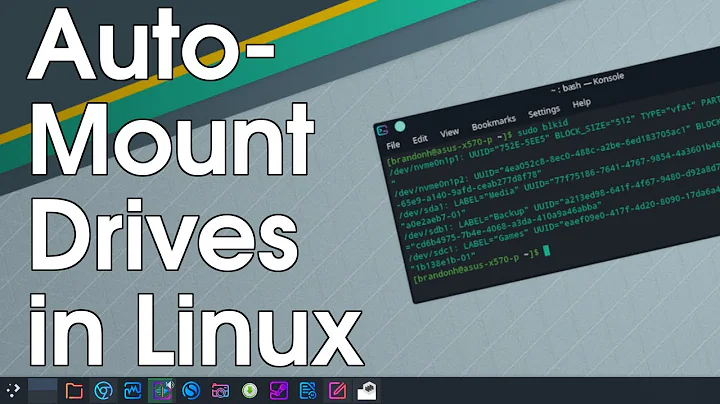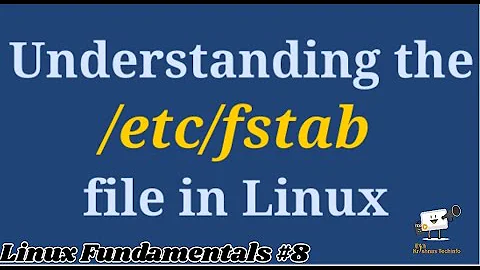How to mount new logical volume (adding to fstab and mtab)?
Solution 1
Yes, you may edit /etc/fstab. /etc/mtab is the same format but a temporary file for what's mounted, leave it alone.
First, make a file system on it. Your system already has ext4 (there are other choices):
mkfs.ext4 /dev/ubuntu-vg/iew-vm-lv
Then find its unique UUID identifier, the line has the name you gave the LV:
blkid
Edit /etc/fstab and add a line similar to this. Your UUID and mount point will be different.
UUID=fcde9bb7-4311-41e2-986a-647a672ebf83 /mnt/example ext4 defaults 0 2
Make this mount point directory and mount it:
mkdir /mnt/example
mount /mnt/example
Edit: a comment was concerned about LVM snapshots, which make a copy of the block device including its UUID. On the first time taking a snapshot, change its UUID:
tune2fs -U random
If using XFS file system, a -U option provides similar functionality, but with a different keyword:
xfs_admin -U generate
Either way, use the new UUID as the snapshot's mount entry.
UUID=b6c7724e-1c58-4960-8830-bfdeb34a9f4f /mnt/example-snap ext4 defaults 0 2
Every time the snapshot is taken, set this snapshot UUID.
tune2fs -U b6c7724e-1c58-4960-8830-bfdeb34a9f4f
You can use several ways to refer to block devices, including for LVM /dev/vg/lv and /dev/mapper/vg-lv. I default to UUID for the same reason the RHEL Storage Administration Guide does. It finds a given file system on any block device it may reside: partitions, LVM volumes, full drives.
Solution 2
Yes, you are supposed to manually edit the fstab file.
- Create a mount point (directory) for the new file system. Say, /new
- Format your new file system. For ext4 the command would be
mkfs.ext4 /dev/ubuntu-vg/iew-vm-lv
- add the following line in /etc/fstab file
/dev/ubuntu-vg/iew-vm-lv /new ext4 defaults 0 0
Now you can mount it.
Related videos on Youtube
Nate
I'm a senior in college, majoring in EE and minoring in CS, with a passion for electronics and programming. I'm an entrepreneur and started a small hobby electronics company called FoxyTronics a few years ago, and am now working on launching a shopping website called PriceWombat.
Updated on September 18, 2022Comments
-
Nate over 1 year
I created a new LV for the first time using this command:
lvcreate -L 20G -n iew-vm-lv /dev/ubuntu-vg #create the new LVWhen I try running
mount /dev/ubuntu-vg/iew-vm-lv, I get the following error:mount: can't find /dev/ubuntu-vg/iew-vm-lv in /etc/fstab or /etc/mtab
How do I add the new LV to those files? Am I supposed to manually edit them?
The current contents of the files are:
# /etc/fstab: static file system information. # # Use 'blkid' to print the universally unique identifier for a # device; this may be used with UUID= as a more robust way to name devices # that works even if disks are added and removed. See fstab(5). # # <file system> <mount point> <type> <options> <dump> <pass> /dev/mapper/ubuntu--vg-root--lv / ext4 errors=remount-ro 0 1 # /boot was on /dev/sda1 during installation UUID=93d4132c-7593-4a9d-901e-30d79db3082d /boot ext2 defaults 0 2 /dev/mapper/ubuntu--vg-home--lv /home ext4 defaults 0 2 /dev/mapper/ubuntu--vg-swap--lv none swap sw 0 0And:
/dev/mapper/ubuntu--vg-root--lv / ext4 rw,errors=remount-ro 0 0 proc /proc proc rw,noexec,nosuid,nodev 0 0 sysfs /sys sysfs rw,noexec,nosuid,nodev 0 0 none /sys/fs/cgroup tmpfs rw 0 0 none /sys/fs/fuse/connections fusectl rw 0 0 none /sys/kernel/debug debugfs rw 0 0 none /sys/kernel/security securityfs rw 0 0 udev /dev devtmpfs rw,mode=0755 0 0 devpts /dev/pts devpts rw,noexec,nosuid,gid=5,mode=0620 0 0 tmpfs /run tmpfs rw,noexec,nosuid,size=10%,mode=0755 0 0 none /run/lock tmpfs rw,noexec,nosuid,nodev,size=5242880 0 0 none /run/shm tmpfs rw,nosuid,nodev 0 0 none /run/user tmpfs rw,noexec,nosuid,nodev,size=104857600,mode=0755 0 0 none /sys/fs/pstore pstore rw 0 0 /dev/sda1 /boot ext2 rw 0 0 systemd /sys/fs/cgroup/systemd cgroup rw,noexec,nosuid,nodev,none,name=systemd 0 0 /dev/mapper/ubuntu--vg-home--lv /home ext4 rw 0 0 -
vic over 5 yearsIn my case, I just mounted the volume manually and copied the new entry in /etc/mtab to /etc/fstab. Do you see any issues with this approach?
-
 John Mahowald over 5 yearsOn Linux, /etc/mtab aka /proc/self/mounts does have mount lines suitable for /etc/fstab. Yes that will work, but you don't need to know about these files to manage mounts. Personally I add lines directly to fstab, which tests the syntax of fstab immediately.
John Mahowald over 5 yearsOn Linux, /etc/mtab aka /proc/self/mounts does have mount lines suitable for /etc/fstab. Yes that will work, but you don't need to know about these files to manage mounts. Personally I add lines directly to fstab, which tests the syntax of fstab immediately. -
vic over 5 yearsI'm not sure I follow when you say "fstab tests the syntax immediately". How do you do this? The only option I know of to check fstab is to run mount -a and look for errors.
-
 John Mahowald over 5 yearsIf you copied from mtab incorrectly, any fstab error might be detected later, perhaps after a reboot. I'm going to be editing fstab anyway, might as well do it first. Test by simply mounting the volume, any errors are usually informative.
John Mahowald over 5 yearsIf you copied from mtab incorrectly, any fstab error might be detected later, perhaps after a reboot. I'm going to be editing fstab anyway, might as well do it first. Test by simply mounting the volume, any errors are usually informative. -
GrGr over 5 yearsIt is not recommended to use UUID for LVMs, because snapshots have the same UUID as the original volume. xanmanning.co.uk/2017/05/29/…
-
 John Mahowald over 5 yearsDefinitely possible to use UUID with LVM snapshots, see my edit. Or you can decide to refer to LVM volumes by name, if that is a stable identifier in your environment.
John Mahowald over 5 yearsDefinitely possible to use UUID with LVM snapshots, see my edit. Or you can decide to refer to LVM volumes by name, if that is a stable identifier in your environment.





